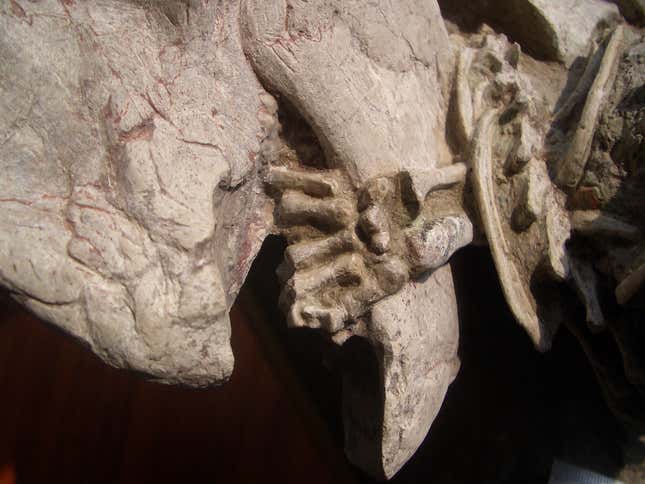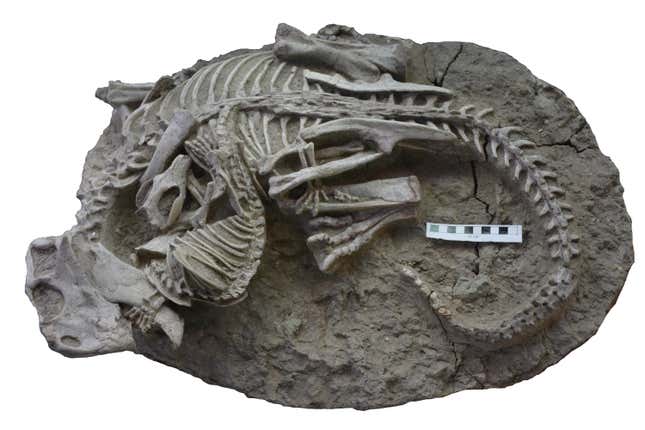About 125 million years ago, a young mammal about the size of a possum bit down on the side of a beaked dinosaur nearly three times its size. The animals died like that, entangled and at odds with each other, a fossilized tableau of the dinosaurian-mammalian power shift that would finally come about 60 million years later.
Those are the certainties of the Cretaceous Period exchange that were encased in time until this week, when a team of paleontologists revealed the stunning fossil in a paper published in Scientific Reports.
The ancient creatures were a Repenomamus robustus, a carnivorous mammal, and a Psittacosaurus lujiatunensis, a beaked, bipedal dinosaur that looks like a cross between a parrot and a lizard (that’s literally what it’s name means, too). The R. robustus is nearly complete, just missing the tip of its tail, and is 18.39 inches (46.7 cm) long. The Psittacosaurus is 47.1 inches (119.6cm) long.
“Almost without exception, dinosaurs were larger than mammals,” Jordan Mallon, a paleobiologist at the Canadian Museum of Nature in Ottawa and co-author of the study, told Gizmodo in an email. “The working assumption has therefore been that dinosaur-mammal interactions were one-way, which is to say that the larger dinosaurs always ate the smaller mammals.”
“This new fossil reveals that these ancient food webs were a little more complete than we might have otherwise assumed, and that mammals were occasionally capable of eating even near fully grown dinosaurs,” he added.

Mallon’s team believes that the two animals died mid-conflict, when a volcanic mudflow ensnared the creatures and buried them. Because the Psittacosaurus didn’t show evidence of being bitten elsewhere, the researchers concluded that the mammal was indeed preying on a live dinosaur rather than scavenging a carcass.
We’re now 65 million years on from the biological handoff which saw the age of dinosaurs come to an end and mammals gain pole position on planet Earth. You may have heard about the cause of the shift; a large asteroid entered Earth’s atmosphere, possibly in the springtime, and slammed into Mexico’s Yucatán peninsula, bringing the age of dinosaurs to an end.
You may recognize the name of the beaked dinosaur featured in the newly announced specimen. Psittacosaurus’ recent claim to fame is the 2021 unveiling of the dinosaur cloaca, the all-purpose hole dinosaurs used for disposing waste and laying eggs.
Despite being soft tissue, that specimen’s cloaca was remarkably preserved thanks to the preservation conditions in Liaoning, China, the region in which it was found. The newly announced fossil was also found in Liaoning, in 2012, west of the village Lujiatun.
The cloaca and the new fossil are both part of the Jehol Biota, a fossil-rich swathe of northeast China with unique preservation conditions. In the paper, the researchers note that fossil forgeries have been reported from the region previously, but given the entanglement of the two creatures in the new fossil, they believed the fossil was genuine.

To be sure, they studied the place where the Repenomamus bit into the Psittacosauris, and concluded that, based on how the mammal’s teeth sunk into the dinosaur’s ribs, the fossil was genuine.
Mallon told Gizmodo that while it’s possible Repenomamus hunted in packs, there’s no evidence to support that idea, and the individual Repenomamus that met its end gum-deep in a Psittacosaurus midriff was capable of taking on such dinosaurs on its own.
The fossil is not just amazing for the state of its preservation, but of its subject matter: interactions between ancient mammals and dinosaurs. Fossilized evidence of such interactions aren’t common, yet 2023 has now seen two such events; earlier this year, a different team of researchers found a Microraptor zhaoinus with a small mammal’s foot in its mouth. That fossil was found—you may have guessed it—in northeast China’s Jehol Biota.
“As productive as the fossil beds of the Lujiatun area are, there are still many unanswered questions about this ancient ecosystem,” Mallon said. “There’s a tendency for those fossil beds to preserve only the small animals that were around at the time. Presumably, the bigger dinosaurs were able to escape the volcanic mudslides that the smaller animals fell victim to, so I would love to know more about the big animals living in that area, which is going to require continued prospecting.”
Prospect on, then, paleontologists. The most intimate windows into deep time show how ancient creatures interacted, not just how they looked. You can now strike “Mammals Taking on Dinosaurs More Than Twice Their Size” off your 2023 bingo card.
More: Some Paleontologists Think They’ve Found Fossilized Dinosaur DNA. Others Aren’t So Sure

